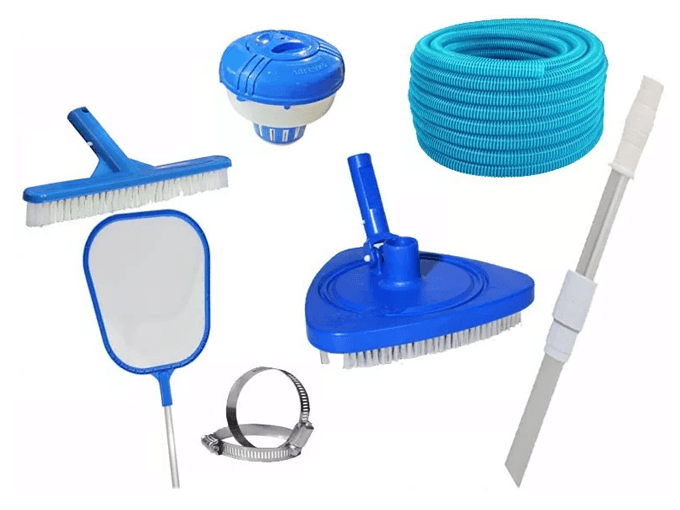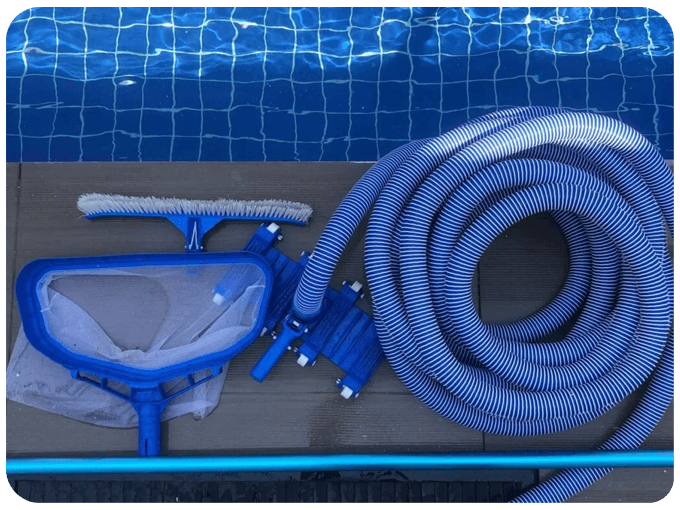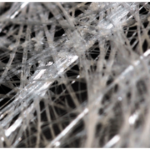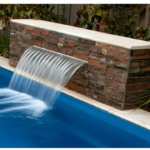Fiberglass pools are an elegant addition to any home, but their maintenance can pose a challenge. In this article, we’ll explore the importance of brushes and leaf skimmers designed specifically for fiberglass pools, providing a comprehensive guide for their selection and effective use.
Table of Contents
Types of Pool Brushes
When it comes to pool brushes, the variety is impressive. From soft nylon brushes to stainless steel brushes, each type serves a unique purpose. But which one is right for your fiberglass pool? Let’s find out.
- Soft Nylon Bristle Brushes: These brushes are made with soft nylon bristles that are ideal for cleaning delicate surfaces like fiberglass pools. They provide gentle yet effective cleaning without damaging the lining.
- Stainless Steel Bristle Brushes: These brushes feature stainless steel bristles that are more resistant and durable. They are useful for removing stubborn stains or algae deposits adhered to the pool surface.
- Mixed Bristle Brushes: These brushes combine soft nylon bristles with stainless steel bristles in one tool. They are versatile and can be used for a variety of cleaning tasks, from light dirt removal to tackling tougher stains.
- Wall Brushes: Specifically designed to clean the side walls of fiberglass pools, these brushes have an angled shape that allows easy access to hard-to-reach areas, removing dirt and algae adhered to the surface.
- Handheld Brushes: These are smaller, compact brushes used to clean small or specific pool areas like stairs, corners, or edges. They are handy for detailed and precise cleaning.
The Importance of Regular Brushing
Regular pool brushing not only improves its appearance but also prevents algae and bacteria buildup. Discover why this simple step can make a difference in water quality and pool durability.
- Dirt and Algae Removal: Regular brushing helps remove dirt, debris, and algae that accumulate on the pool surface and walls. This prevents these residues from sticking and accumulating, which could lead to water quality issues and liner deterioration.
- Stain and Discoloration Prevention: By regularly brushing the pool surface, you can prevent the buildup of stains and discoloration caused by mineral accumulation, chemicals, or other contaminants. This helps maintain the pool’s visual appearance and preserves its aesthetic over time.
- Improved Water Circulation: Brushing helps improve water circulation by removing obstructions and deposits on the pool surface and walls. Better water circulation contributes to more even chemical distribution and enhances the effectiveness of filtration and disinfection systems.
- Preparation for Chemical Treatment: Regular brushing prepares the pool surface for chemical treatment by breaking down the surface layer of dirt, allowing chemicals to penetrate the water more effectively. This maximizes treatment effectiveness and helps maintain proper chemical balance in the pool.
- Extended Liner Lifespan: By removing dirt and contaminants from the pool surface, regular brushing helps protect and extend the lifespan of the fiberglass liner. This reduces the need for costly repairs and helps maintain the structural integrity of the pool over time.

Choosing the Right Brush
Not all brushes are the same, and choosing the right one can make a difference in maintenance effectiveness. From bristle type to handle, here’s a comprehensive guide to selecting the perfect brush.
- Bristle Type: Opt for a brush with soft nylon or mixed bristles if your fiberglass pool is prone to scratching or damage. These bristles are gentler and less abrasive, ideal for delicate surfaces.
- Brush Length and Shape: Choose a brush with suitable length and shape for your fiberglass pool. If you have a large pool, you may prefer a longer brush to cover a larger area in less time. Also, consider the brush shape, such as wall brushes for efficient wall cleaning.
- Compatibility with Telescopic Handle: Check if the brush is compatible with a telescopic handle. This allows you to adjust the handle length to easily reach all pool areas without overstretching.
- Durability and Water Resistance: Look for a brush made of durable, water-resistant materials to ensure longevity and optimal performance even in adverse conditions.
- Ease of Use and Maintenance: Choose a brush that is easy to use and maintain. Consider aspects like brush weight, handle design for comfortable and ergonomic grip, and ease of cleaning the brush after use.
- Price and Quality: Consider your budget and look for a brush that offers good value for money. It’s not always necessary to opt for the most expensive option; look for a brush that meets your needs and expectations at a reasonable price.
- Reviews and Recommendations: Before making a final decision, consult reviews and recommendations from other users about the brush you’re considering. Others’ experiences can provide valuable insights into the brush’s performance and effectiveness in real-world conditions.
Additional Tools: Leaf Skimmers
In addition to brushes, leaf skimmers are essential tools for keeping your fiberglass pool clean. We’ll explore the different types available and how they can streamline the cleaning process.
- Fine Mesh Leaf Skimmers: Equipped with a fine mesh net, these leaf skimmers allow you to collect leaves, insects, and other floating debris from the water surface without letting them escape. They are ideal for trapping small particles and keeping the pool clean and free of debris.
- Leaf Skimmers with Detachable Bag: These leaf skimmers come with a detachable bag that makes it easy to remove collected debris. Once the bag is full, it can be easily removed, emptied, and reattached to the leaf skimmer to continue cleaning.
- Weighted Edge Leaf Skimmers: Some leaf skimmers are designed with a weighted edge that helps keep them upright in the water, making it easier to collect leaves and other debris without sinking or slipping beneath the surface.
- Telescopic Handle Leaf Skimmers: These leaf skimmers come with a telescopic handle that can be adjusted in length as needed. This allows you to reach hard-to-access areas in the pool without stretching or bending too much, making the cleaning process easier and reducing strain on the user’s body.
- Specifically Shaped Leaf Skimmers: Some leaf skimmers are designed with a specific shape, such as a curved or angled head, which allows more efficient cleaning of hard-to-reach areas like pool corners or steps.
Ideal Maintenance Routine with Brushes and Leaf Skimmers for Pools
A well-planned maintenance routine is key to a pristine pool. From brushing frequency to skimmer cleaning, we’ll guide you through an efficient and straightforward routine.
- Daily:
- Remove Floating Debris: Use a leaf skimmer to remove leaves, insects, or other debris that may be floating on the water surface.
- Check the Skimmer: Ensure that the skimmer is functioning correctly and empty its basket if necessary to prevent water flow obstructions.
- Brush Walls and Floor: Brush the pool walls and floor with a soft bristle brush to remove any dirt or algae adhered to them.
- Weekly:
- Empty and Clean the Skimmer and Filter: Remove the skimmer basket and clean it, removing any trapped debris. Also, check and clean the pool filter according to the manufacturer’s instructions to ensure optimal operation.
- Check and Adjust Chemical Levels: Use a water testing kit to check pH, chlorine, and alkalinity levels in the pool and adjust chemical levels as necessary to maintain proper balance.
- Monthly:
- Clean Waterline: Use a specific cleaner to remove grease and dirt buildup on the waterline around the pool edge.
- Check and Adjust Filter Pressure: Verify the filter pressure and make any necessary adjustments to ensure optimal water flow through the filtration system.
- Quarterly:
- Perform Deep Cleaning: Dedicate time to perform a thorough cleaning of the pool, including walls, floor, and fixtures. You can also consider partially draining the pool to clean the liner and remove any mineral or chemical buildup.
- Annually:
- Inspect and Maintain Equipment: Inspect and perform any necessary maintenance on pool equipment such as the pump, filter, skimmer, and cleaning accessories. Be sure to follow the manufacturer’s recommendations and, if necessary, consult a professional for repairs or adjustments.

Common Problems and Solutions
From filtration system obstructions to stubborn stains, we’ll address common issues that fiberglass pool owners may encounter and how to solve them.
- Cracks or Fissures: Cracks or fissures in the fiberglass liner can result from impacts, temperature changes, or ground settlements. For small cracks, they can be repaired using a fiberglass repair kit. For larger cracks or structural issues, it’s advisable to consult a professional.
- Liner Wear or Discoloration: Over time, the fiberglass liner may wear out or discolor due to exposure to elements and constant use. To keep the liner in good condition, use gentle cleaning products and avoid using abrasive objects that may scratch it. You can also consider applying a sealer or coating to protect and restore the liner’s shine.
- Algae and Stain Buildup: Fiberglass can be prone to algae and stain buildup, especially in areas with low water circulation. To prevent algae formation, ensure you maintain chlorine levels and regularly clean the pool. To remove stains, use specific fiberglass pool products and gently brush the affected surface.
Special Care for Fiberglass Pools
Fiberglass pools require specific care. Discover essential tips to ensure your pool maintains its splendor and durability over the years.
- Avoid Impacts and Sharp Objects: Fiberglass can easily be damaged by impacts or sharp objects. Avoid leaving sharp objects near the pool and be careful when moving furniture or other items around it.
- Monitor Water pH and Chemical Levels: Fiberglass can deteriorate if the pool water has either too low or too high pH levels, as well as imbalanced chemical levels. Maintain pH, chlorine, and alkalinity levels within recommended ranges to avoid damage to the liner.
- Avoid Sudden Temperature Changes: Sudden temperature changes can cause contractions and expansions in fiberglass, which could lead to cracks or liner damage. Avoid filling the pool with extremely cold or hot water and use a thermal cover to help maintain stable water temperature.
- Regular Maintenance: Perform regular pool maintenance, including cleaning the surface and fixtures, checking the filtration system, and periodically inspecting for potential damage or signs of wear.
FAQs about Pool Brushes and Leaf Skimmers
- How often should I brush my fiberglass pool?
- Maintaining a weekly brushing routine is ideal for preventing unwanted buildup.
- Can I use any brush on a fiberglass pool?
- No, it’s crucial to choose a brush with soft bristles to avoid damaging the pool surface.
- Do leaf skimmers work on all types of pools?
- Yes, there are options tailored for pools made of different materials, including fiberglass.
- What is the typical lifespan of a pool brush?
- It depends on usage and care, but on average, a good brush can last several seasons.
- Can I leave the leaf skimmer in the pool during winter?
- It’s advisable to store the leaf skimmer in a dry place during winter months to prolong its lifespan.
Conclusion
In summary, choosing and using the right brushes and leaf skimmers are crucial for maintaining your fiberglass pool in optimal condition. Investing in quality tools translates into a pristine and durable pool.


